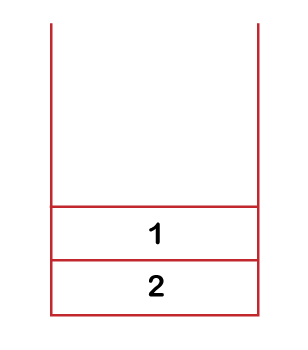Working professionals
Fresh graduates
- Study abroad
- Offline centres
More
14. Radix Sort
20. AVL Tree
21. Red-Black Tree
23. Expression Tree
24. Adjacency Matrix
36. Greedy Algorithm
42. Tower of Hanoi
43. Stack vs Heap
47. Fibonacci Heap
49. Sparse Matrix
50. Splay Tree
Stack vs Heap: What's the difference?
Computer science and programming require a coherent understanding of memory allocation to write meaningful and error-proof code. Memory is an integral resource for any developer when producing software or apps. The input flow for each of these software creation approaches is consistent with the hardware requirements.
With this, developers hand-pick the most fitting data structure formats to perform memory management by hand. Because of this reality, it becomes necessary to be familiar with the entire range of implications of memory. Then, let’s learn Heap vs Stack – memory allocation in C and C++.
Two primary memory allocation methods, stack and heap, play a pivotal role in this domain. This article delves into the nuances of stack vs heap memory allocation, elucidating the differences and their implications in various programming scenarios.
What is Stack?
One type of data structure for data organization is a stack. Stacks are comparable to the way real-world objects are arranged in stacks. A few real-world examples of stacks are a stack of dinner plates, a stack of tennis balls, and the Tower of Hanoi, a mathematical puzzle with three rods and several discs. A stack is a collection that requires something to be taken out of the top end, which is where the item or object is located.
It cannot be seen as a property; rather, it is regarded as a limitation placed on the stack. To put it another way, we could argue that just the top of the stack is reachable and that anything can be added to or taken out of it. It adheres to the LIFO (Last In First Out) principle, which states that the most recent piece added to the stack should be deleted first.
A stack is a list or collection that is restricted to allowing insertions and deletions only from the top of the stack, which is its end.
Operation of a Stack
The two operations that can be performed with a stack ADT are as follows:
- Push: A push operation is the act of adding an element to a stack. The posh operation is expressed as follows:
The function push(x) adds element x to the stack.
- Pop: A pop operation is the act of removing an element from the stack. The pop operation looks like this:
- Pop(): It clears the stack of its most recent entry.
Stack's representation is displayed below:

The stack appears to be a container that is opened from one side, as seen in the above illustration. Logically, it can be depicted as a three-sided figure with one side of the container open. Let's assume that the empty stack in the above form is a's'. It's an integer stack. We will now push and pop items from the stack. Let's say we wish to add two elements to the stack. Following a push operation, the stack might resemble this:

Two elements would be at the top of the stack because there is only one element in the stack. The stack would prefer the following if we were to introduce one element into it:

Element 1 would be regarded as the top of the stack since it is positioned above Element 2. The top element, or 1, would be eliminated from the stack if we performed the pop operation, as demonstrated below:

What is a Heap in Software Engineering?
Global variables are also stored in a heap, a type of memory or data structure. By default, all global variables are kept in heap memory, which permits the dynamic allocation of memory. The CPU does not handle heap memory. Trees or arrays can be used to build a heap data structure.
It is a complete binary tree, meaning all levels—aside from the final one—are fully filled. It complies with the heap property criteria. All nodes are as far to the left as they can be in the final level.
Heap Memory Allocation
When programmers execute their written instructions, memory is allocated. Keep in mind that the heap data structure and its name are unrelated. Because programmers can create and release memory space from this pile, it is known as a heap. Whenever we construct an object, it always does so in Heap-space, and the references to these objects are kept in Stack-memory. Because all threads can access or see the data stored in this region, heap memory allocation is less secure than stack memory allocation. An improper handling of this memory by the programmer may result in a memory leak.
Three categories are added to the heap memory allocation process, which aids in prioritizing the data (i.e., objects) that should be placed in the heap memory or the garbage collection.
- Young Generation: This is the memory area used to hold newly created objects and data. When this memory is fully used, the remaining data is disposed of in the garbage collection.
- The Old or Tenured Generation: This is the area of Heap-memory where older data objects that are either rarely or never used are stored.
- Permanent: The part of heap memory known as permanent generation is where the JVM's metadata about the runtime classes and application methods is stored.
Example in Python:
In Python, objects are stored in heap memory. When an object is created using the new keyword, or through object instantiation, memory is dynamically allocated from the heap to store the object's attributes and methods. For example:
class MyClass:
def __init__(self, data):
self.data = data
obj = MyClass(10)
In this example, the obj instance of MyClass is allocated memory on the heap to store its data attribute.
Pointers and Dynamic memory
Understanding how the system handles memory and makes it available to programmers is vital. In a common architecture, the memory allocated to the program or application is separated into four sections. The instructions that need to be followed are kept in one section of the memory.
Static or global variables are kept in a different section of memory. Global variables are declared outside of functions and have a lifetime that spans the entire program.
The function calls and local variables are all stored in the third section, sometimes known as the stack. Any function that is called takes up memory space in what is called stack memory.
The use of stack memory has some restrictions. Assume the operating system allots the program one megabyte of stack memory. Programs that repeatedly call functions risk running out of stack memory, which can result in stack overflow. A stack overflow causes a software crash. Thus, it may be concluded that runtime stack memory does not grow.
Another drawback of the stack is the inability to modify the variable's scope. The rule determines how memory is allocated and deallocated onto the stack; when a function is called, the memory is pushed to the top of the stack, and when the pop() operation is called, the memory is removed from the top of the stack.
The third constraint on the stack arises when we define a huge data type, like an array, whose size is not specified during compilation. The array's size needs to be defined based on certain criteria, and the stack prevents runtime array size definition.
Thus, we can use a heap data structure to allocate big memory chunks and set them aside for the duration of our choice. In contrast to stack data structures, heap memory has a variable size that changes during an application. There are no hard and fast rules for allocating and releasing memory in heap memory. The RAM can be manually managed by a programmer. The programmer's abstracted method of viewing the heap as a sizable amount of free memory is at our disposal to use however we see fit.
Thus, we can use a heap data structure to allocate big memory chunks and set them aside for the duration of our choice. In contrast to stack data structures, heap memory has a variable size that changes during an application. There are no hard and fast rules for allocating and releasing memory in heap memory. A programmer can manually manage the RAM. The programmer's abstracted method of viewing the heap as a sizable amount of free memory that is at our disposal to use however we see fit.
Differences Between Stack and Heap
Heap | Stack |
Dynamic memory allocation is provided by heap. All global variables are kept on the heap by default. | Static memory allocation is provided via the stack, which is why temporary variables are kept there. |
Because of its hierarchical data structure, the elements are kept in a tree-like format. | Because it is a linear data structure, the elements are kept one after the other in a linear fashion. |
By default, it is utilized to access the global variables. | To access the local variables, utilize it. |
The memory has no upper limit on its size. | A stack's memory size limit is imposed by the operating system. |
Element storage is random because the data structure is hierarchical. | Since it's a linear data structure, the information is kept in consecutive blocks. |
Memory in heaps is manually maintained. | Three methods exist for implementing a stack: array, linked list, and dynamic memory. |
There are two ways to implement heap: with arrays and with trees. | Three methods exist for implementing a stack: array, linked list, and dynamic memory. |
Memory fragmentation is the primary problem with a heap. Memory waste is the result of memory fragmentation in this case. | Because the memory size cannot be altered at runtime, the primary problem with a stack is memory scarcity. At the time of compilation, the stack's size is decided. |
Because we may adjust the heap's size to suit our demands, it is adaptable in use. | It has a set size. |
In a heap, access times are slower. | In a stack, access times are quicker. |
Programmers determine how much memory is allocated to heaps. | The operating system determines how much the stack memory should be. |
It is possible to alter the variable's scope. | It is not possible to alter the variable's scope. |
Here’s an Example of stack vs heap data structure
Here’s an illustration of each type of memory allocation Java's Heap and Stack:
class Emp {
int id;
String emp_name;
public Emp(int id, String emp_name) {
this.id = id;
this.emp_name = emp_name;
}
}
public class Emp_detail {
private static Emp Emp_detail(int id, String emp_name) {
return new Emp(id, emp_name);
}
public static void main(String[] args) {
int id = 21;
String name = "Maddy";
Emp person_ = null;
person_ = Emp_detail(id, name);
}
}
Some Applications of Stack
Some of the most common applications of stacks include:
- Function call management in programming languages.
- Storing local variables and function parameters.
- Implementing recursion in algorithms and data structures.
Some Applications of Heap
The heap memory allocation is used in various scenarios including:
- Dynamic data structures like linked lists, trees, and graphs.
- Object-oriented programming for storing objects and class instances.
- Memory allocation for large data storage and dynamic memory management.
Frequently Asked Questions
1. What is the difference between a stack and a heap data structure?
Stack: LIFO structure, stores function call information and local variables. Heap: Dynamically allocated memory for objects and data structures like arrays. Why is the stack faster than the heap?
2. Why is the stack faster than the heap?
Stack access is faster due to its LIFO nature and direct memory allocation, while heap access involves pointers and dynamic memory management, resulting in slower access times. What is the difference between stack and heap array?
3. What is the difference between stack and heap array?
Stack array: Fixed size, allocated automatically, limited by stack size. Heap array: Dynamically allocated, size can vary, requires manual memory management. What is bigger, stack or heap?
4. What is bigger, stack or heap?
Heap is typically larger than stack, as stack size is limited and predetermined, while heap size can vary dynamically. What is the main difference between stack and heap memory?
5. What is the main difference between stack and heap memory?
Stack memory is managed automatically, limited in size, and used for function call information and local variables. Heap memory is manually managed, larger, and used for dynamic memory allocation. Is RAM a stack or a heap?
6. Is RAM a stack or a heap?
RAM (Random Access Memory) consists of both stack and heap memory. The stack portion is used for function call stacks and local variables, while the heap portion is used for dynamically allocated memory.
Author|0


upGrad Learner Support
Talk to our experts. We are available 7 days a week, 10 AM to 7 PM
Indian Nationals
Foreign Nationals
Disclaimer
The above statistics depend on various factors and individual results may vary. Past performance is no guarantee of future results.
The student assumes full responsibility for all expenses associated with visas, travel, & related costs. upGrad does not .






















-7f4b4f34e09d42bfa73b58f4a230cffa.webp&w=128&q=75)
-ae8d039bbd2a41318308f8d26b52ac8f.svg)



